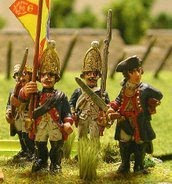 Hesse-Cassel Musketeer Regiment v. Donop was raised in 1687. It fought at Brooklyn, White Plains, Fort Washington and during the Pennsylvania campaign of 1778-1780, after which it was stationed in New York. It was a member of Major-General v. Stirn's Brigade.
Hesse-Cassel Musketeer Regiment v. Donop was raised in 1687. It fought at Brooklyn, White Plains, Fort Washington and during the Pennsylvania campaign of 1778-1780, after which it was stationed in New York. It was a member of Major-General v. Stirn's Brigade.These are a mix of Foundry and Front Rank figures. I was unsure of the figure mix considering I painted them over 2 years ago, but Giles Allison from the Tarlton's Quarter AWI Blog helped me out with the identification (see the comments he posted below). Thanks Giles! The flag is another of my own creations done on my ink-jet printer. I've painted officers for each stand so that both stands can be used as different regiments/battalions in large-scale games while still being able to represent a two-stand unit in lower level games.







3 comments:
Excellent - you have a mix of both Foundry and Front Rank there Allan. The Foundry guys have gaiters and the Front Rank fellows have overalls. They work well together. What scale do you use when both stands represent the regiment? Is it 1:33?
Giles
(Edited for more information) V&B scales don't relate to men per figure. Each stand represents a regiment or batallion of varying sizes. It's a bit more abstract than traditional rule sets. At the highest level a stand can have 1-3 strength points, each strength point representing approximately 250 men, so on average, they run anywhere from 1:30 to 1:50 depending on how large a regiment or batallion is.
The two-stands are for lower scales where each strength point can represent less soldiers. There are 4 scales: 250,125,75,40 men per strength point. For AWI I use 250 for large battles, and wing scale 75 men per strength point for smaller battles. In different figure scales the ground scales the time scale is adjusted so that movement stays the same. Each turn represents a shorter amount of time. Shooting ranges are adjusted for that.
So to answer your question:
Two stands can be used in the 125 men per strength point (sp) and 75 men per sp scales. That means assuming a regiment of about 500 men, the stands are either representing the whole batallion at 125/sp making them about 1:45, or 2 stands would represent only a portion of the regiment or a battalion at a scale of about 1:20.
Using a single stand for a regiment will create a scale of anywhere from 1:50 to 1:80 depending on how large the regiment is.
The abstraction is that what matters to battles is maneuver elements, wheather they be regiments, brigates of several small regiments, or battalions of a larger regiment. It's a very high-level rule set.
There should be a new version of it out this year. We like it a lot for many different black-powder periods, especially napoleonics and AWI. The best thing about getting one rule set we all know well is games become contests of generalship instead of contests of rules familliarity.
Post a Comment